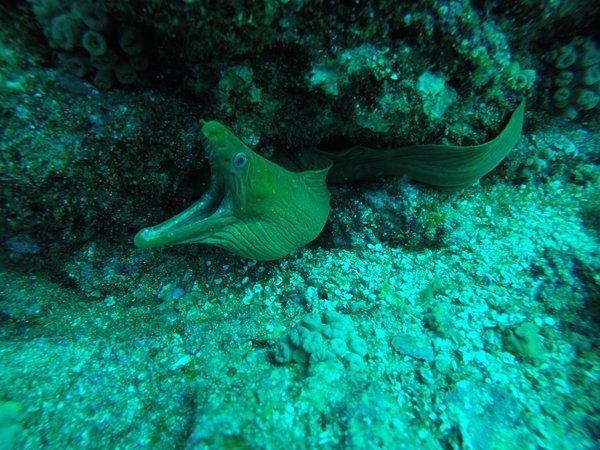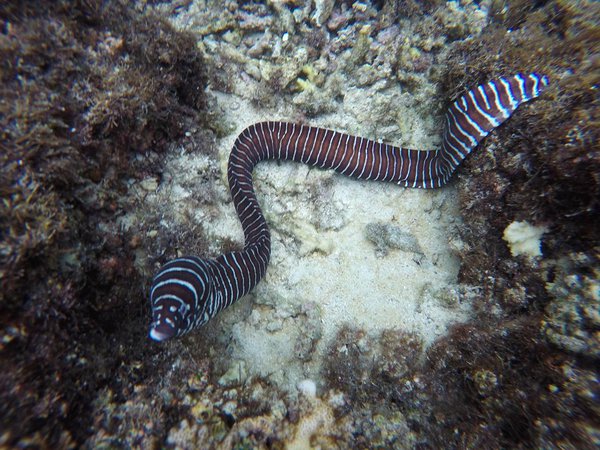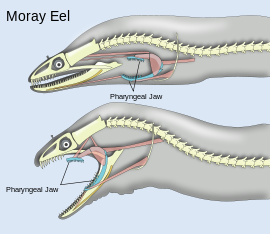It's a Moray!
Ursulas' sidekicks in the little mermaid - not everyones favourite creature but they are pretty amazing.
Moray eels can be found throughout the world and they come in various shapes and sizes. In La Paz there are three that I see regularly (green, jewel and starry) and some others which are a little less common. They are a little different to many of the other types of fish we see on the reef; they are often found lurking in a hole or a crevice and they look like they are guarding their home by menacingly trying to bite you. However intimidating this might look they are actually not trying to bite you but rather they are just breathing! As moray eels are not constantly swimming around the reef they need to pass fresh water over their gills to bring in fresh oxygen, by opening and closing their mouth they are forcing water over their gills; breathing not biting!
Moray eels are typically more active at night, during the day we usually see them hiding away in the shadows. At night they are more likely to be seen in their entirety, free swimming across the reef or sliding amongst rocks or parts of the reef in pursuit of prey. They have a great sense of smell but poor eyesight therefore they do not rely on being able to see their prey in order to catch it. At night it is easier for them to surprise their prey sleeping in the reef or rocks. When swimming around they may look like a snake in the water but they are members of the fish family who have some interesting adaptations. They have lost their pectoral and pelvic fins and the usually separate dorsal, caudal and anal fins are fused into one long sinuous fin that extends the length of their body. Their swimming pattern looks like a gymnasts ribbon and they are capable of great speeds.
The body of a moray eel is covered in a protective layer of mucus. When you look closely at an eel you don't see it covered in numerous scales but more like a layer of skin. Instead of the scales eels have a protective skin that secretes a mucus coating as this helps to prevent infection. We should never touch animals that we see underwater but particularly moray eels, as when we touch them it removes that protective layer and makes them vulnerable. Some eels live in burrows in the sand and the layer of mucus on their skin helps to protect their home - it allows the grains of sand to stick together thus making their home more stable. The mucus layer may also affect their camouflage and colouration. Most species of green moray eels are actually brown without their mucus layer but when a yellow coating is added they turn a nice bright green!
Often eels are seen alone on the reef but they display an unusual cooperative behaviour when it comes to hunting. They get involved in group hunts, usually with a grouper in a pattern called nuclear hunting. The two fish will shadow each other around the reef and when a good area is spotted the eel can wiggle into small cracks and crevices to help flush fish out and the grouper blocks the exit hole. this way the fish will either get pushed out into the jaws of the waiting group of scared back into the mouth of the moray.
Talking about the moray's mouth brings me to one of my favourite facts about moray eels. The part that makes them seem completely alien and even more freaky and in need of being watched carefully if found on a dive. They have two sets of jaws. Yes 2 sets of sharp teeth. There is the regular jaw lied with sharp teeth that we observe during the respiration process, however there is also a second set lurking back in their throat. This second set of jaws are called pharyngeal jaws. When the regular mouth bites down on its prey, these pharyngeal jaws then extend up from within their throat to bite onto the prey and pull it down into the eel. Very little chance for that prey to escape!
So as with many creatures that we see when diving or snorkelling moray eels are masters of adaptation to their environment and far more interesting (to me anyway!) when you know a little more about them. Look out for their hunting behaviour next time you spot one at night or take a close look at their mouth and watch them breathing. Interesting creatures that deserve our attention, just remember, look but don't touch.
Moray eels are typically more active at night, during the day we usually see them hiding away in the shadows. At night they are more likely to be seen in their entirety, free swimming across the reef or sliding amongst rocks or parts of the reef in pursuit of prey. They have a great sense of smell but poor eyesight therefore they do not rely on being able to see their prey in order to catch it. At night it is easier for them to surprise their prey sleeping in the reef or rocks. When swimming around they may look like a snake in the water but they are members of the fish family who have some interesting adaptations. They have lost their pectoral and pelvic fins and the usually separate dorsal, caudal and anal fins are fused into one long sinuous fin that extends the length of their body. Their swimming pattern looks like a gymnasts ribbon and they are capable of great speeds.
The body of a moray eel is covered in a protective layer of mucus. When you look closely at an eel you don't see it covered in numerous scales but more like a layer of skin. Instead of the scales eels have a protective skin that secretes a mucus coating as this helps to prevent infection. We should never touch animals that we see underwater but particularly moray eels, as when we touch them it removes that protective layer and makes them vulnerable. Some eels live in burrows in the sand and the layer of mucus on their skin helps to protect their home - it allows the grains of sand to stick together thus making their home more stable. The mucus layer may also affect their camouflage and colouration. Most species of green moray eels are actually brown without their mucus layer but when a yellow coating is added they turn a nice bright green!
Often eels are seen alone on the reef but they display an unusual cooperative behaviour when it comes to hunting. They get involved in group hunts, usually with a grouper in a pattern called nuclear hunting. The two fish will shadow each other around the reef and when a good area is spotted the eel can wiggle into small cracks and crevices to help flush fish out and the grouper blocks the exit hole. this way the fish will either get pushed out into the jaws of the waiting group of scared back into the mouth of the moray.
Talking about the moray's mouth brings me to one of my favourite facts about moray eels. The part that makes them seem completely alien and even more freaky and in need of being watched carefully if found on a dive. They have two sets of jaws. Yes 2 sets of sharp teeth. There is the regular jaw lied with sharp teeth that we observe during the respiration process, however there is also a second set lurking back in their throat. This second set of jaws are called pharyngeal jaws. When the regular mouth bites down on its prey, these pharyngeal jaws then extend up from within their throat to bite onto the prey and pull it down into the eel. Very little chance for that prey to escape!
So as with many creatures that we see when diving or snorkelling moray eels are masters of adaptation to their environment and far more interesting (to me anyway!) when you know a little more about them. Look out for their hunting behaviour next time you spot one at night or take a close look at their mouth and watch them breathing. Interesting creatures that deserve our attention, just remember, look but don't touch.


